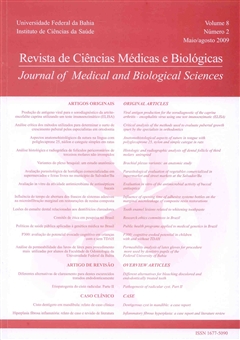Influence of opening time of adhesive systems bottles on the marginal microleakage of composite resin restorations.
DOI:
https://doi.org/10.9771/cmbio.v8i2.4067Keywords:
Adhesive systems – Solvents- Dental leakageAbstract
The aim of this in vitro study was to evaluate the influence of repeated opening of two adhesive systems bottles, an acetone based and an ethanol/water based, on the marginal microleakage of composite resin restorations. To reproduce the clinical routine, the opening periods of 15 seconds in restoratives procedure and the amount of restorations accomplished in one day (8 patients/day) were accounted. Four adhesives system bottles, Prime & Bond NT (PBNT), Dentsply (acetone based), and Adper Single Bond 2 (SB2), 3M ESPE (ethanol/water based) were daily opened, 8 times of 15 seconds for 0, 30, 60 and 90 days. One hundred twelve Class V cavities located at the cemento-enamel junction were prepared in bucal and lingual surfaces of human third molars and it were randomly divided into 8 groups, in which the adhesive systems were used as follows: G1: PBNT, no opening; G2: SB2, no opening; G3: PBNT, 30 days of opening; G4: SB2, 30 days of opening; G5: PBNT, 60 days of opening; G6: SB2, 60 days of opening; G7: PBNT, 90 days of opening; e G8: SB2, 90 days of opening. The cavities were restored with composite resin – Filtek Z250 (3M ESPE). After finishing and the polishing teeth were thermocycled (500 cycles at 5ºC + 2º and 55ºC + 2º). The radicular apices were sealed with composite resin – Filtek Z250, and the teeth were coated with fingernail varnish within 1mm the margin of the restorations. The teeth were immersed in 0,5% buffered methylene blue solution for 24 hours at 37ºC and sectioned in a bucalingual direction using a diamond disc in three sections which were inspected under a stereomicroscope using a digital pachymeter to measure the microleakage in millimeters. Statistical analysis was performed using a two-way ANOVA, Tukey’s Test and T Student. There was no statistically significant difference for Prime & Bond NT and Adper Single Bond 2 considering the periods of opening. The microleakage was higher in dentin than enamel margins (p < 0,05). There was no statistically significant difference among the adhesive systems about sealing ability and avoiding the microleakage. Based on the experimental conditions tested, it may be concluded that the opening of adhesive’s bottles performed in clinical routine and the possible solvent volatilization didn’t increase the microleakage in the composite resin restorations.Downloads
Download data is not yet available.
Downloads
Published
2009-06-02
How to Cite
Libório Lago, C. da C., & Bezerra, R. B. (2009). Influence of opening time of adhesive systems bottles on the marginal microleakage of composite resin restorations. Journal of Medical and Biological Sciences, 8(2), 162–170. https://doi.org/10.9771/cmbio.v8i2.4067
Issue
Section
ORIGINAL ARTICLES
License
The Journal of Medical and Biological Sciences reserves all copyrights of published works, including translations, allowing, however, their subsequent reproduction as transcription, with proper citation of source, through the Creative Commons license. The periodical has free and free access.


